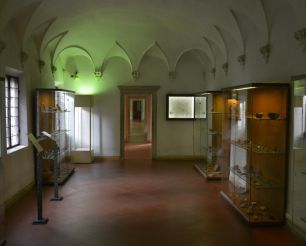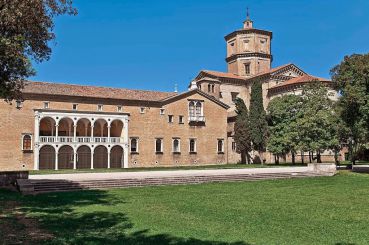National Museum, Ravenna

The Ravenna National Museum (Museo Nazionale di Ravenna) is the largest state museum of Ravenna. Throughout the years it was being filled with numerous exhibits that are related to the province in some way. While traveling through the museum you can learn a lot about the rich history of Ravenna and discover its cultural heritage.
History of the Ravenna National Museum
The origins of the museum can be traced back to the early 18th century when the Camaldolese monks carried out their activities. Their scientists were the ones who created the first collections that mainly were religiously themed. The pieces were kept in the mausoleum, in Classe, suburban area of Ravenna. During the Napoleon occupation monastic orders were eliminated, then in the late 18th century, every exhibit they gathered came into Ravenna’s ownership. In 1804 city authorities founded the first municipal museum. In the late 18th century the collection grew larger, then an overhaul on the exhibition space was performed in 1884. Later in 1885, it was officially established by the state. In 1912 the museum was moved to the place where it can be found today – monumental complex of San Vitale. In 1993 the museum had another major restoration aimed to make it more modern.
Museum collections
There are a great number of various pieces that reflect the historical and cultural heritage of Ravenna in the museum. The most ancient exhibit dates back to the Bronze Age and the most recent one – to the late 19th century. The monastery itself is considered to be the most fascinating part of city’s cultural heritage. Museum’s collections, such as lapidary, archaeological, the one that includes bronze artifacts, fabrics, coins, weapons, and clothes, are put on display in several halls on the ground level. The place also boasts a vast fine and applied art selection which consists of paintings, sculptures, ivory statuettes, ceramics, icons, frescos and valuable mosaics. Among all this variety there are pieces that stand out the most:
- Grave steles. A row of skillfully made headstones can be found in the oldest part of the monastery that dates back to the 15th century. They were put on graves that belonged to the soldiers and sailors of Roman garrison of the Classe port. The most famous stele was dedicated to Publius Longidienus, the garrison carpenter.
- Ancient busts. Five busts created back in the antique Greece and Rome were found in Rome in the late 15th century and then sent to a museum in Ferrara by sea. The ship, however, sunk and later the sculptures were found near Ravenna. The city decided to keep it.
- Chess pieces. Masterly created chess pieces date back to the 12th–13th century and originate from Scandinavian countries. They are small-scale and very precisely carved out of unusual material – walrus tooth.
- Mosaic floor. The originality of this artwork lies in the fact that from far away it looks like a carpet. Geometrical mosaic ornaments resemble those you can see on carpets of 17th–18th century.
- Inkwell. It was shaped as a bronze statuette of a satyr that holds a container for the ink. The piece dates back to the 15th century when such items were quite popular in high society.
- Statue of Heracles. It was made of white marble and depicts one of the hero’s labors – the hunt for the golden deer. The sculpture was created in the 6th century, in Byzantium.
- Bas-relief of Augustus. A series of bas-reliefs made of white marble portrays the first Roman emperor Augustus and his wife dressed as ancient gods Jupiter and Venus.
- Frescos. The sequence consists of 8 frescos created by Pietro da Rimini in the first half of the 14th century. Originally they were placed in the church called Santa Chiara in Ravenna. Episodes from the earthly life of Jesus Christ are illustrated on these artworks, the most well-known one is “The Adoration of the Magi.”
How to get
The museum is located in the north of the historical part of Ravenna, on Via San Vitale, 17. There are Porta Adriana and the famous Mausoleum of Galla Placidia. The closest bus stop is Piazza Baracca located 3 minutes away. You can catch the bus № 70 there.
Opening hours: from 08:30 till 19:30 every day, except for Mondays. The ticket office closes at 19:00. Contact numbers: (+39) 0544 543710, (+39) 0544 543720. Contact number for booking: (+39) 0544 21 39 02.
Admission: a full ticket costs 6 euros, a reduced one – 3 euros (available for students between the ages of 18 and 25.) Children under the age of 18 are free of charge. Entry is also free on the first Sunday of the month.
The information is relevant for July 2018.








